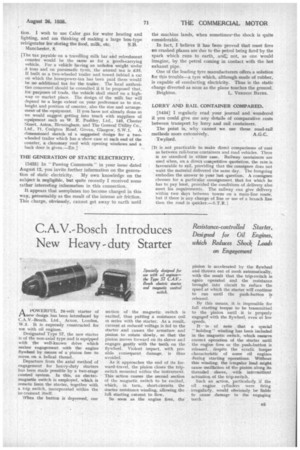C.A.V.-Bosch Introduces New Heavy duty Starter
Page 39

If you've noticed an error in this article please click here to report it so we can fix it.
[A A POWERFUL 24-volt starter of
new design has been introduced by C.A.V.-Bosch, Ltd., Acton, London, W.3. It is expressly constructed for use with oil engines.
Designated Type S7, the new starter is of the non-axial type and is equipped with the well-known drive which makes engagement with the engine flywheel by means of a pinion free to move on a helical thread.
Departure from the axial method of engagement for heavy-duty starters has been made possible by a two-stage control system. In this, an electromagnetic switch is employed, which is remote from the starter, together with a trip switch, incorporated within the ingrument itself.
When the button is depressed, one
section of the magnetic switch is excited, thus putting a resistance coil in series with the starter. As a result, current at reduced voltage is fed to the starter and causes the armature and pinion to rotate slowly, so that the pinion moves forward on its sleeve and engages gently with the teeth on the flywheel. Violent impact, with possible consequent damage, is thus avoided.
As it approaches the end of its forward-travel, the pinion closes the tripswitch mounted within the instrument. This action causes the second section of the magnetic switch to he excited, which, in turn, short-circuits the starter resistance winding, allowing the full starting current to flow.
So soon as the engine fires, the
pinion is accelerated by the flywheel and thrown out of mesh automatically, with the result that the trip-switch is again operated and the resistance brought into circuit to reduce the speed at which the starter will continue to run until the push-button is released.
By this means, it is impossible for full starting torque to be transmitted to the pinion until it is properly engaged with the flywheel, even at low speeds.
It is of note that a special "
holding" winding has been included in the magnetic switch, which ensures correct operation of the starter mita the engine fires or the push-button is released, despite the erratic torque characteristic of some oil engines during starling operations. Without this winding, the irregular load might cause oscillation of the pinion along its threaded sleeve, with intermittent actuation of the trip-switch.
Such an action, particularly if the oil engine cylinders were firing irregularly, would obviously be liable to cause damage to the engaging teeth.




















































































